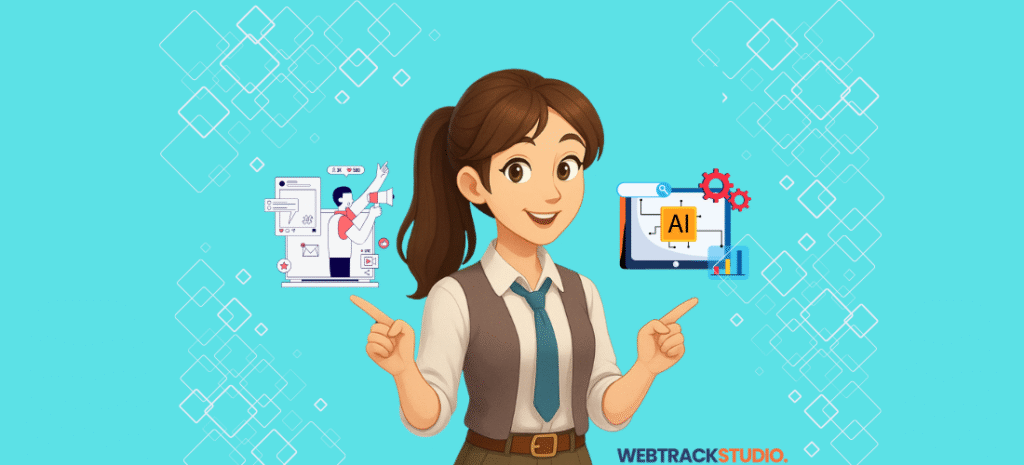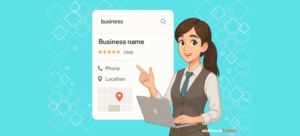Table of Contents
- Here's what's actually happening:
- What AI Marketing actually does
- Why traditional marketing still works
- How to choose the right option for Your Business
- Common mistakes that you should avoid
- Implementation Steps and What to Do
- How to decide which path to choose (Decision Framework)
- Frequently Asked Questions
- Conclusion
AI isn’t magic. Traditional marketing isn’t dead.
Here’s what’s actually happening:
- Most small businesses already use AI tools (often without realizing it)
- Traditional methods like word-of-mouth still drive the majority of customers
- The fastest-growing businesses strategically blend both approaches
Bottom line: Stop thinking “either/or” and start thinking “which combination.”

What AI Marketing actually does
Think of AI as a tireless assistant. It works 24/7, handles repetitive tasks, and learns from data.
AI Tools You’re Probably Using
- Google Ads Smart Bidding
- Adjusts your ad spend in real-time
- Maximizes clicks without budget waste
- Facebook Ad Targeting
- Finds people who match your best customers
- Places ads directly in front of them
- Email Platforms (Mailchimp, ConvertKit)
- Determines optimal send times per subscriber
- Delivers messages when people actually check email
- Customer Service Chatbots (Tidio, Intercom)
- Answers questions at 2 AM
- Handles basic inquiries instantly
Benefits
- 24/7 Automation – Marketing runs while you sleep
- Personalization at Scale – Custom messages to thousands
- Pattern Recognition – Spots trends you’d miss (like Tuesday afternoon sales spikes)
- Cost Efficiency – Automatically shifts budget to winning campaigns
- Time Savings – Eliminates manual, repetitive tasks
Where AI Falls Short
- Can’t replace genuine human connection
- Requires monitoring (not “set and forget”)
- Can sound robotic if poorly implemented
- Needs 60+ days to learn and optimize
Why traditional marketing still works
Technology supports trust. It doesn’t create it.
Core Advantages
- Trust Building
- People trust human recommendations over algorithms
- Critical for new businesses in tight-knit communities
- Local Connection
- Shows you’re part of the community, not a faceless company
- Essential for service businesses and retail stores
- Tangible Impact
- Physical materials remind customers you exist
- Works for high-ticket items requiring trust
- Immediate Feedback
- Real conversations let you read body language
- Adjust your pitch on the fly
- No Tech Barriers
- Reaches every customer, including those who avoid technology
- Perfect for older demographics and traditional industries
How to choose the right option for Your Business
No one-size-fits-all solution exists. Your strategy depends on your business model.
- E-commerce / Online Businesses
- AI Focus (70%): Automated emails, personalized ads, retargeting, behavior tracking
- Traditional Focus (30%): Influencer partnerships, PR, trade publications
- Why: AI drives sales; traditional builds credibility
- Local Services (Plumbers, Salons, Restaurants)
- AI Focus (40%): Review management, automated follow-ups, social scheduling
- Traditional Focus (60%): Local ads, word-of-mouth, community involvement, sponsorships
- Why: Traditional brings customers; AI keeps them engaged
- Professional Services (Lawyers, Consultants, Accountants)
- AI Focus (50%): Lead nurturing, content automation, email sequences
- Traditional Focus (50%): Referrals, direct meetings, speaking events, networking
- Why: AI generates leads; traditional closes deals
- B2B Companies
- AI Focus (50%): LinkedIn automation, lead scoring, CRM integration, webinar funnels
- Traditional Focus (50%): Trade shows, conferences, sales calls, partnerships
- Why: AI nurtures prospects; traditional builds relationships
- Retail Stores
- AI Focus (45%): Loyalty programs, SMS marketing, online inventory ads
- Traditional Focus (55%): In-store events, local partnerships, direct mail
- Why: Traditional drives foot traffic; AI increases loyalty
Common mistakes that you should avoid
AI Marketing Mistakes
- Believing AI does everything automatically
- Setting up and forgetting
- Replacing all human touchpoints
- Sending robotic messages
- Expecting overnight results
Fix: Treat AI as your assistant, not your replacement.
Traditional Marketing Mistakes
- Clinging to outdated methods
- Not measuring what works
- Wasting time at low-value events
- Ignoring digital presence
- Not asking: “How did you hear about us?”
Fix: Keep the human touch, back it with data.
The biggest mistake is thinking it’s AI vs traditional when success comes from blending both.
Implementation Steps and What to Do
You don’t need a massive budget or marketing degree. You need a simple plan and follow-through.
Phase 1: Assess Your Situation (Week 1-2)
Get brutally honest:
- List everything you’re doing for marketing right now
- Rate each: High impact, Medium impact, or Low impact
- Answer two critical questions:
- Which tasks eat most of my time?
- Where do most customers find me?
Pro tip: If you can’t answer the second question, you’ve found your first problem.
Phase 2: Pick Your Starting Point (Week 3-4)
If you’re traditional-heavy, add these AI tools:
- Email automation: Mailchimp, ConvertKit
- Social scheduling: Buffer, Hootsuite
- Review alerts: Google My Business
- Customer chatbots: Tidio, Intercom
If starting fresh:
- Use the hybrid approach based on your business type (see table above)
Phase 3: Measure & Adjust (Month 2+)
Track what matters:
- Cost per customer from each marketing source
- Time spent on each activity weekly
- Customer feedback: “How did you hear about us?”
Simple rule: If it’s not working after 60 days, kill it. If it’s crushing it, do more.
How to decide which path to choose (Decision Framework)
Use this framework to determine your ideal marketing mix:
Choose AI-Heavy (70/30) If:
- You sell primarily online
- Your customers research heavily before buying
- You serve a wide geographic area
- Scalability is your main growth challenge
- You have limited time for manual tasks
Choose Traditional-Heavy (60/40) If:
- You depend on local foot traffic
- Your service requires in-person consultations
- Your target market is 55+ years old
- Trust-building happens through face-to-face interaction
- You’re established in your community
Choose Balanced (50/50) If:
- You serve both local and online markets
- Your sales cycle has multiple touchpoints
- You’re in professional services or B2B
- Lead generation and relationship-building are equally important
- You have moderate budget flexibility
Immediate Action Item
Pick ONE from each category:
- AI Tool to Try
- Email automation (easiest start)
- Social media scheduling (best time-saver)
- Traditional Method to Strengthen
- Commit to two networking events this month
- Launch a local partnership or sponsorship
- Tracking to Implement
- Ask last 10 customers: “How did you find us?”
- Document answers in a simple spreadsheet
Remember: The best strategy fits YOUR business, YOUR customers, YOUR schedule.
Frequently Asked Questions
Start with $50-100/month. Most essential tools (Mailchimp, Buffer, Google My Business) have free tiers. Focus on solving one pain point first.
No. AI handles repetitive tasks so you can spend MORE time building genuine relationships.
Modern AI marketing tools are designed for non-tech users. If you can use email and social media, you can handle these tools.
Absolutely not. Keep what’s working and add AI tools to handle time-consuming tasks.
Traditional marketing can show results within weeks. AI needs 60-90 days to learn and optimize. Expect meaningful results in 90 days with a blended approach.
Conclusion
The AI versus traditional marketing debate is a false choice.
The winning formula:
- Use AI to handle repetitive tasks and scale efficiently
- Use traditional marketing to build trust and genuine relationships
- Measure everything and adjust based on real data
- Start small, test constantly, and double down on what works
Your competitors are still arguing about which approach is “better.” Meanwhile, smart business owners are using both strategically—and they’re winning.
The question isn’t which to choose. It’s how quickly you’ll start combining them.
Ready to create a marketing strategy that actually works for your business? Connect with us for a FREE SEO audit and customized growth plan.


